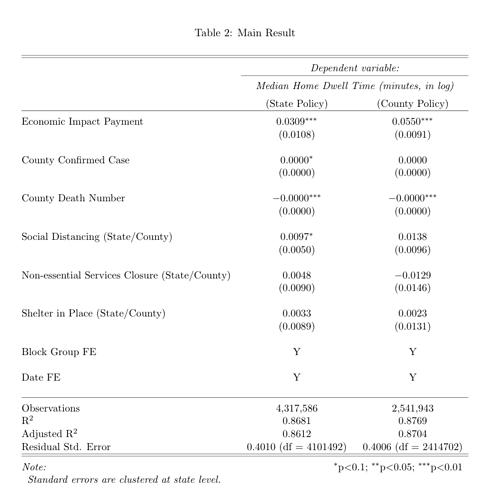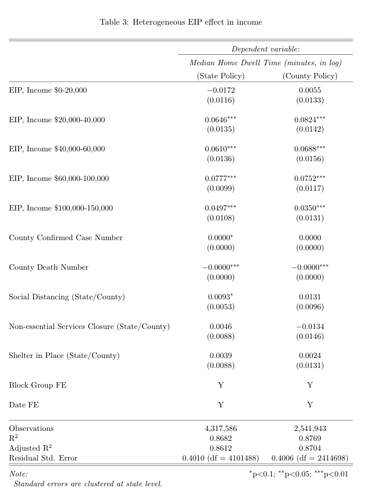Hi all, my recent working paper “Income Effect in Private Contribution of Public Goods: Economic Impact Payment in the COVID-19 Pandemic” finds that receiving economic impact payment (stimulus check) significantly increases the individual home dwell time during the pandemic, especially for the middle class with household annual income between $60,000 and $100,000. However, it shows zero effect to these with household annual income below $20,000, because their home dwell time is bounded by the government mandatory orders. Here is the link of the full paper: https://www.researchgate.net/publication/341388910_Income_Effect_in_Private_Contribution_of_Public_Goods_Economic_Impact_Payment_in_the_COVID-19_Pandemic Comments welcomed! Screen Shot 2020-05-17 at 10.57.02 AM
Hi @Ruohao_ZHANG_Binghamton_University, thanks for sharing this interesting work! I have a few comments/questions.
Can you provide some speculation as to why these results were found?
- For example, in Section 2.1 you assume y_i (individual income) is constant across time. Are lower income jobs more/less likely to have gotten laid off/furloughed/decreased hours?
- Additionally, do lower income jobs have less flexibility to work from home than higher income jobs?
- Are there any considerations needed for the date people received their stimulus payment? I understand that people with direct deposit set up were able to receive their payments much earlier, while some have still not received their payment. If lower income households are significantly less likely to have direct deposit (no idea if they are, just speculating), they would receive their checks later. Could this impact analysis?
Are you testing the changes in home dwell time from past data grouped by income-level group? If so, how far into the past are you looking?
Thanks again for sharing your work!
You might be interested in the working paper recently posted by @Tao_Wang_Johns_Hopkins_University, linked below.
https://safegraphcovid19.slack.com/archives/C0114RJA0BW/p1589550227417800
Also, a few potential typos I found:
• Page 3 “By contributing [to] the mitigation effort”
• Page 5 “…and each individual only contribute_[s]_ at the mandatory…”
• In Section 2.2, is “…after setting a mandatory consumption requirement…” supposed to be “…after setting a mandatory contribution requirement…”?
• Section 2.2 “…yields a_[n]_ increase in the public good contribution…”
• Section 4.2 “51 states” should be “50 states and Washington D.C.” (assuming Washington D.C. was the extra “state”)
• Page 11 “[Since] census only report the income at household…” (delete “Since")
Hi @Ryan_Kruse_MN_State, thank you very much for your comments and the typo you found!! I wrote the paper in a short time, sorry about the typo!
I have revised the paper and add small sections regarding to your concerns. They are all very useful.
I hope I answer your questions appropriately. Thank you again! Feel free to post any follow-up questions!
@Ryan_Kruse_MN_State And thank you for sharing the working paper recently posted by @Tao_Wang_Johns_Hopkins_University!
Super interesting!
@Ruohao_ZHANG_Binghamton_University Thank you for your response! You answered all of my questions thoroughly. Great work!

